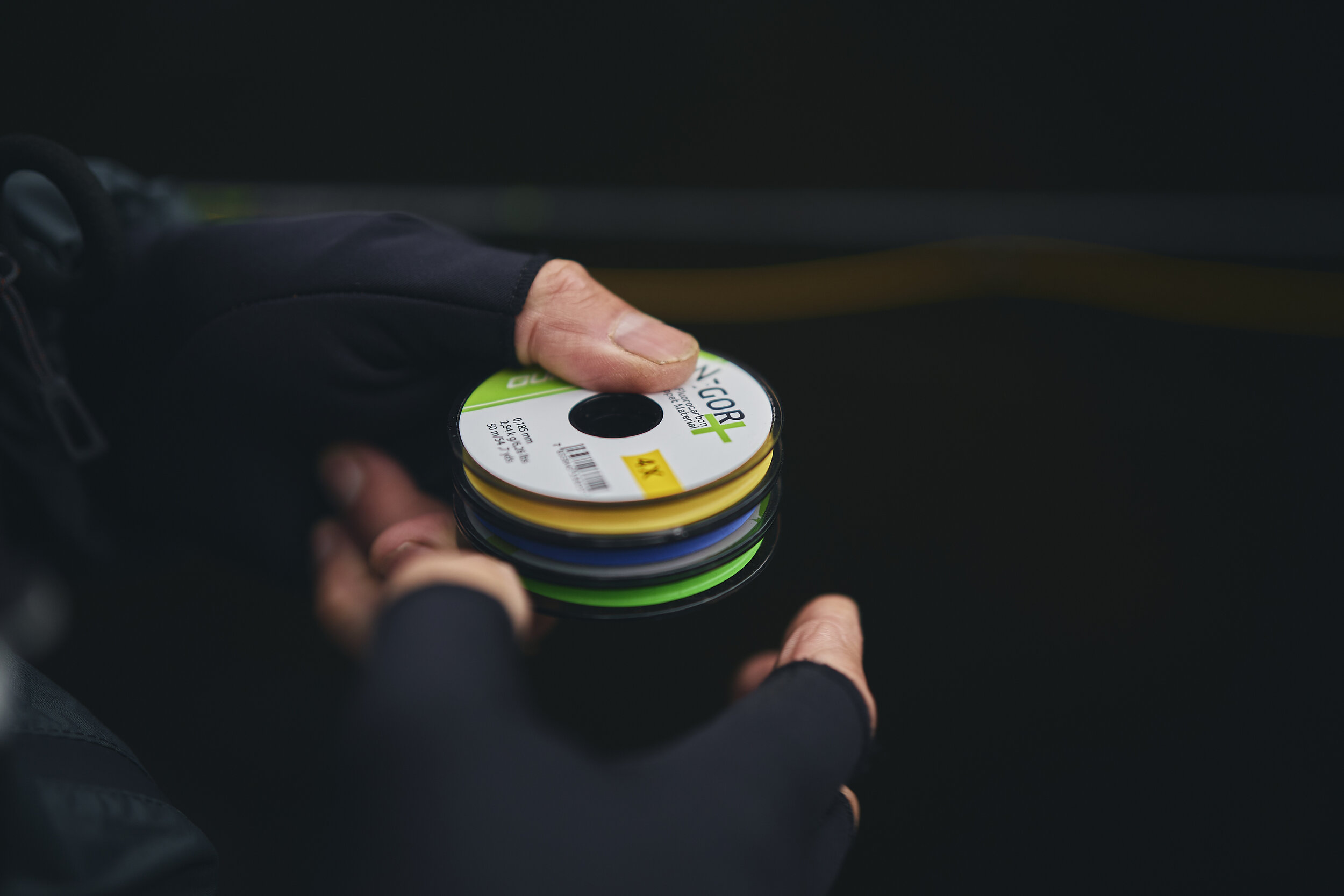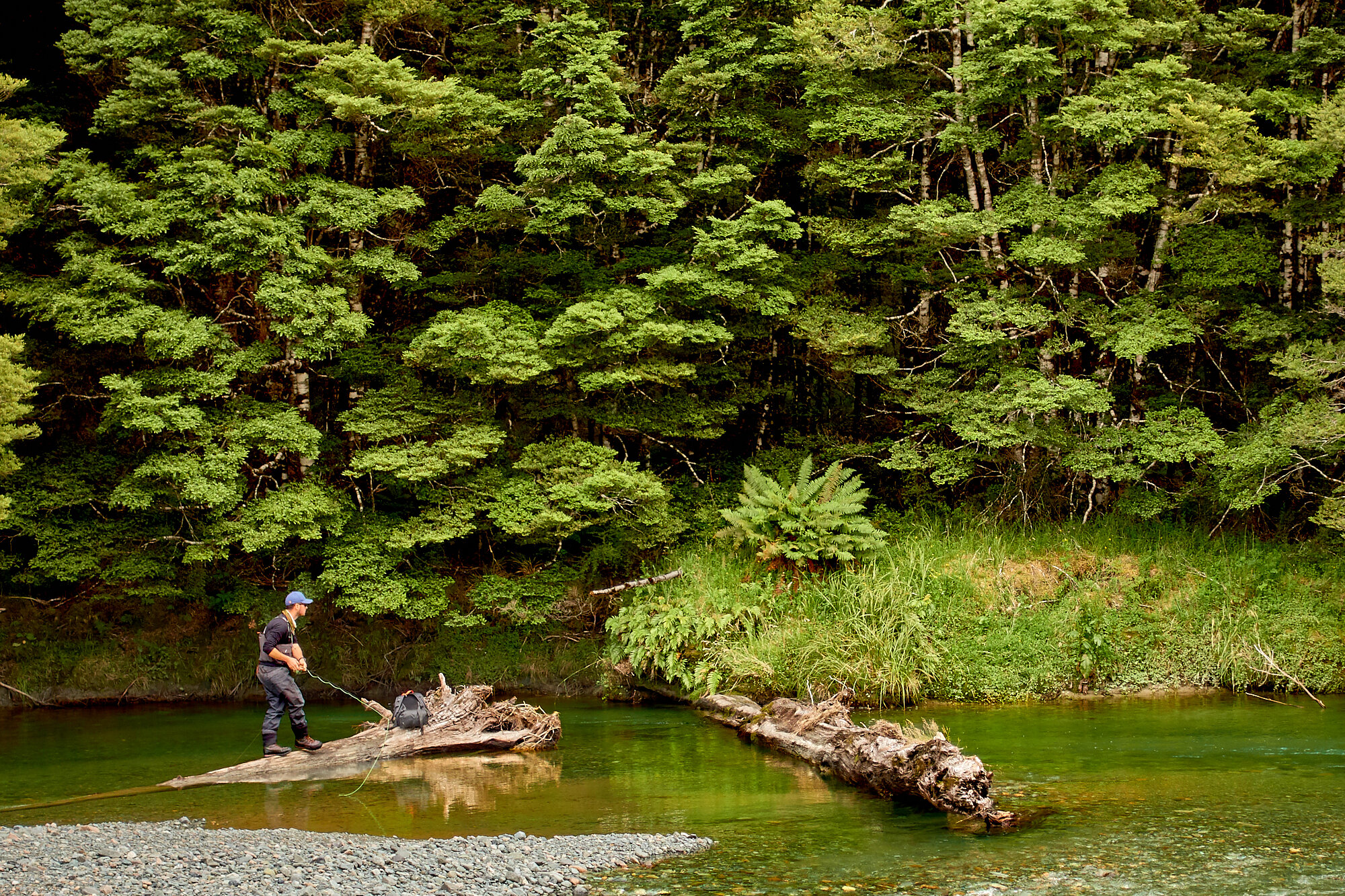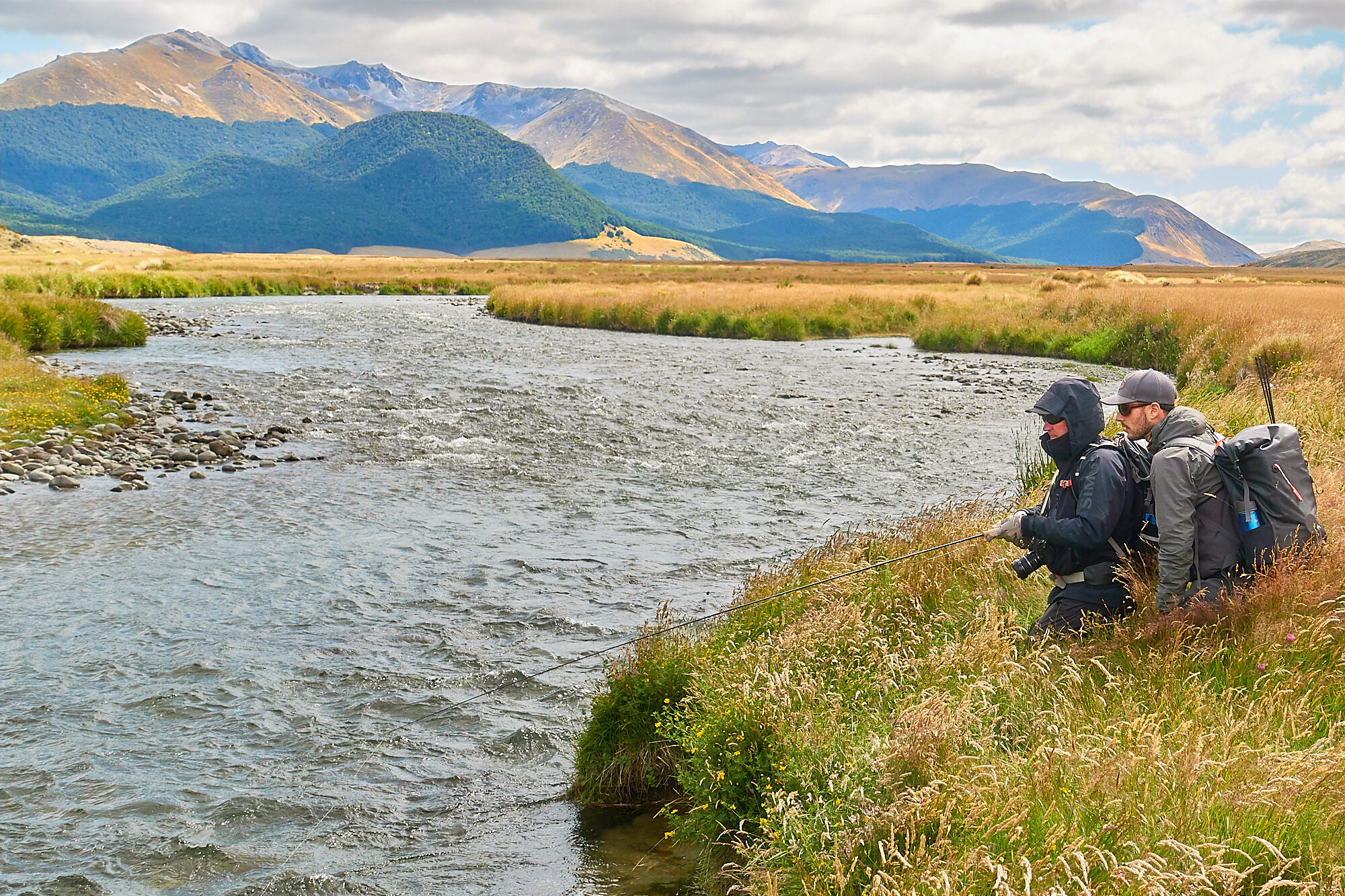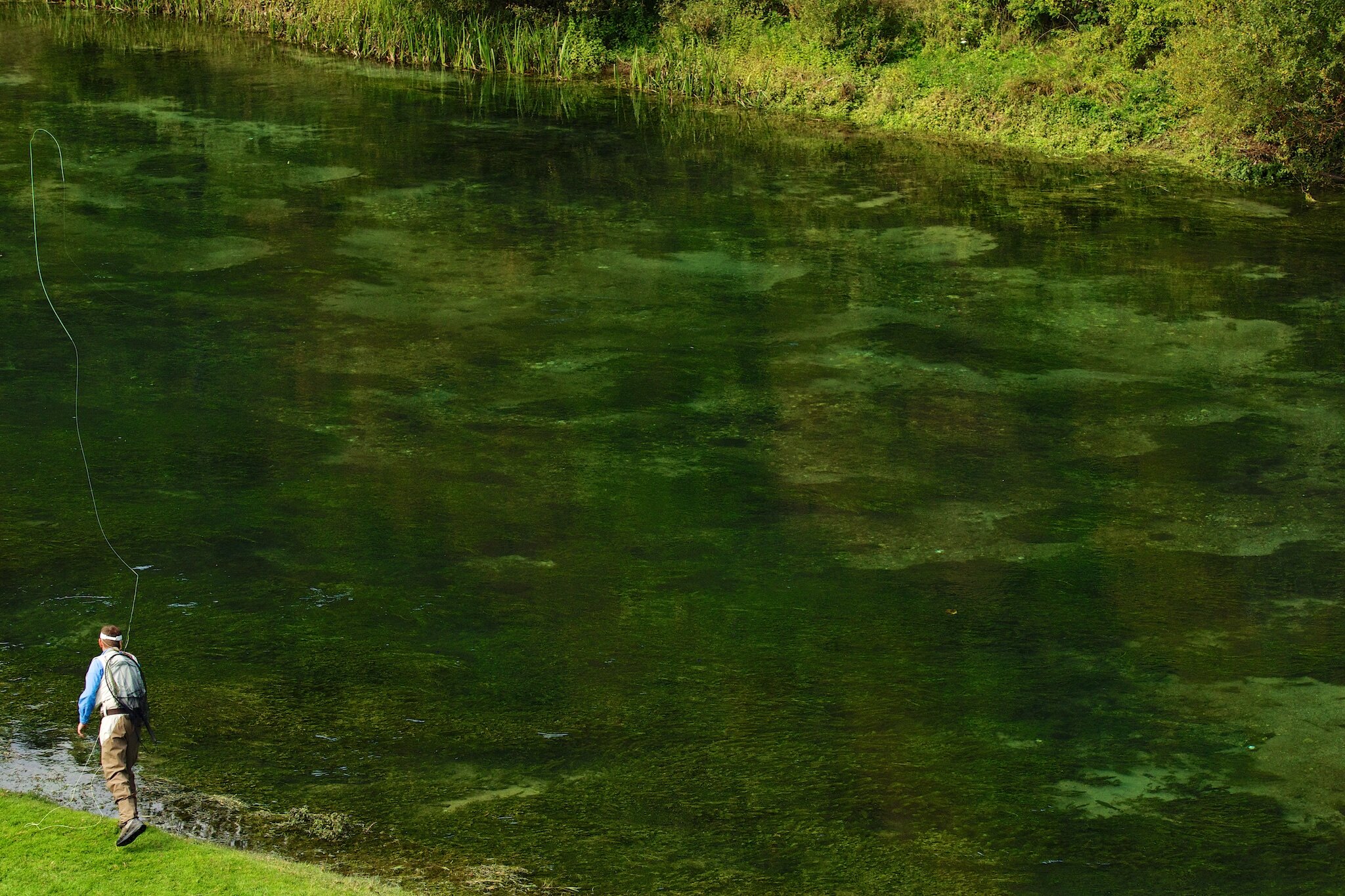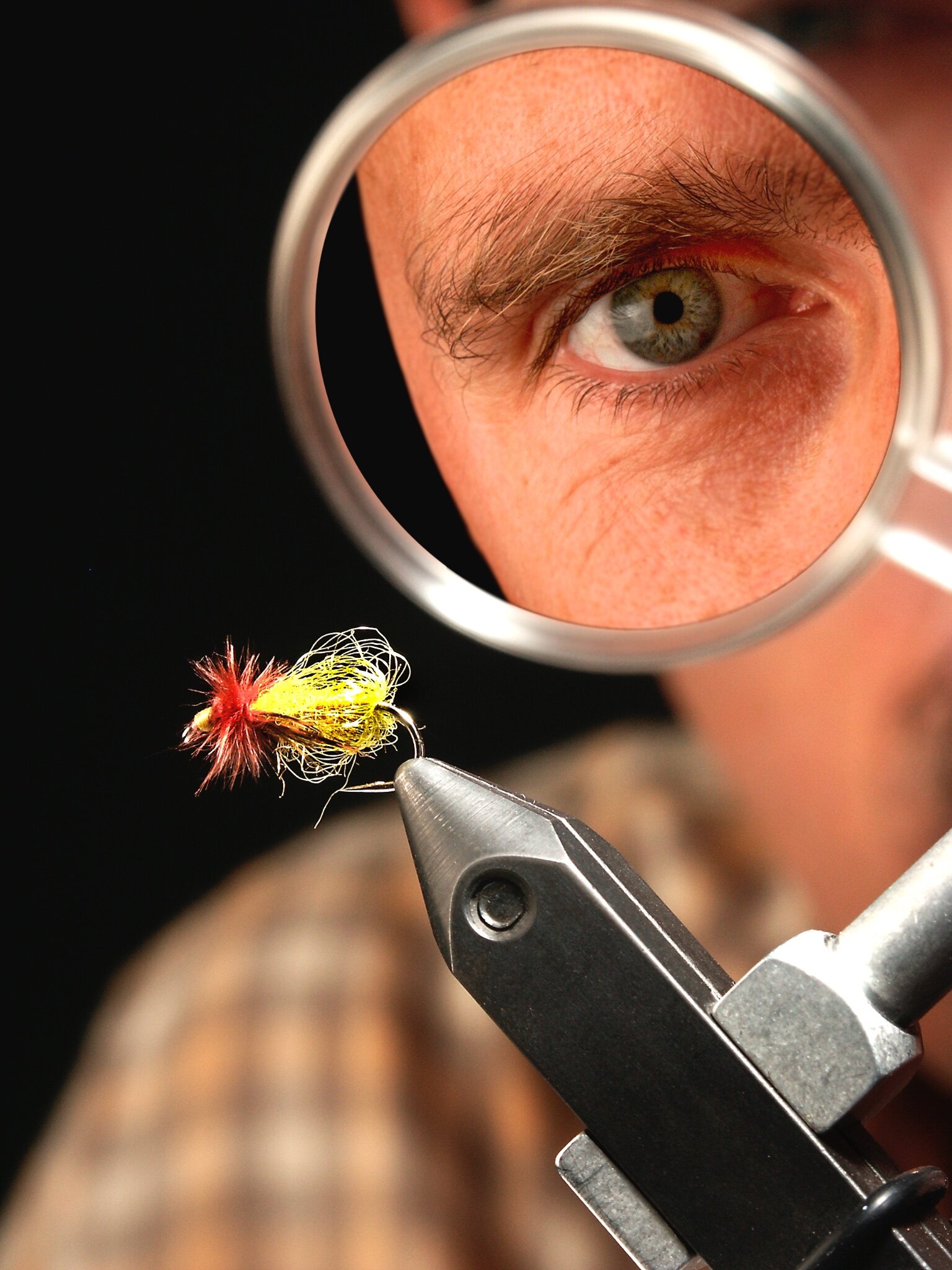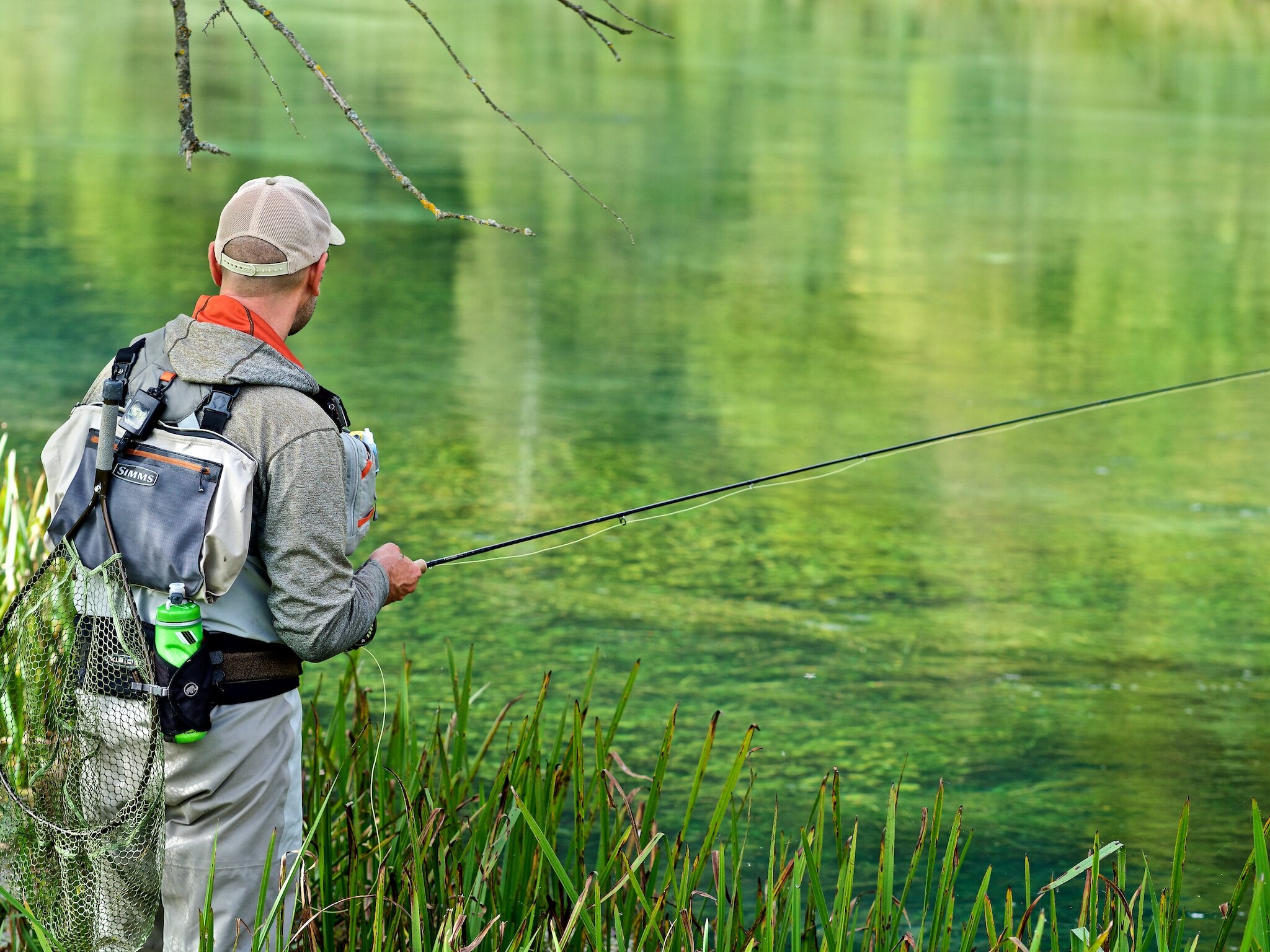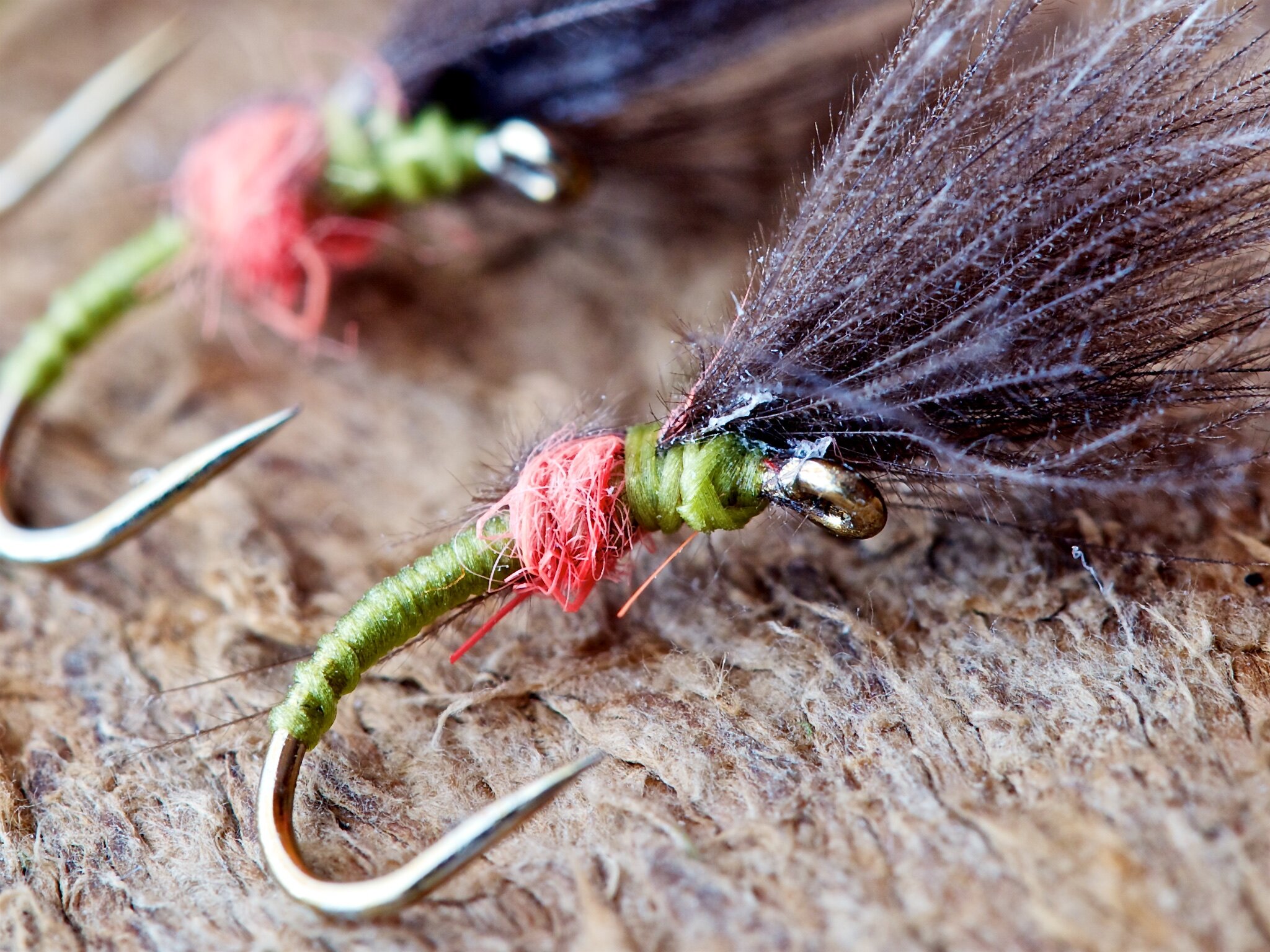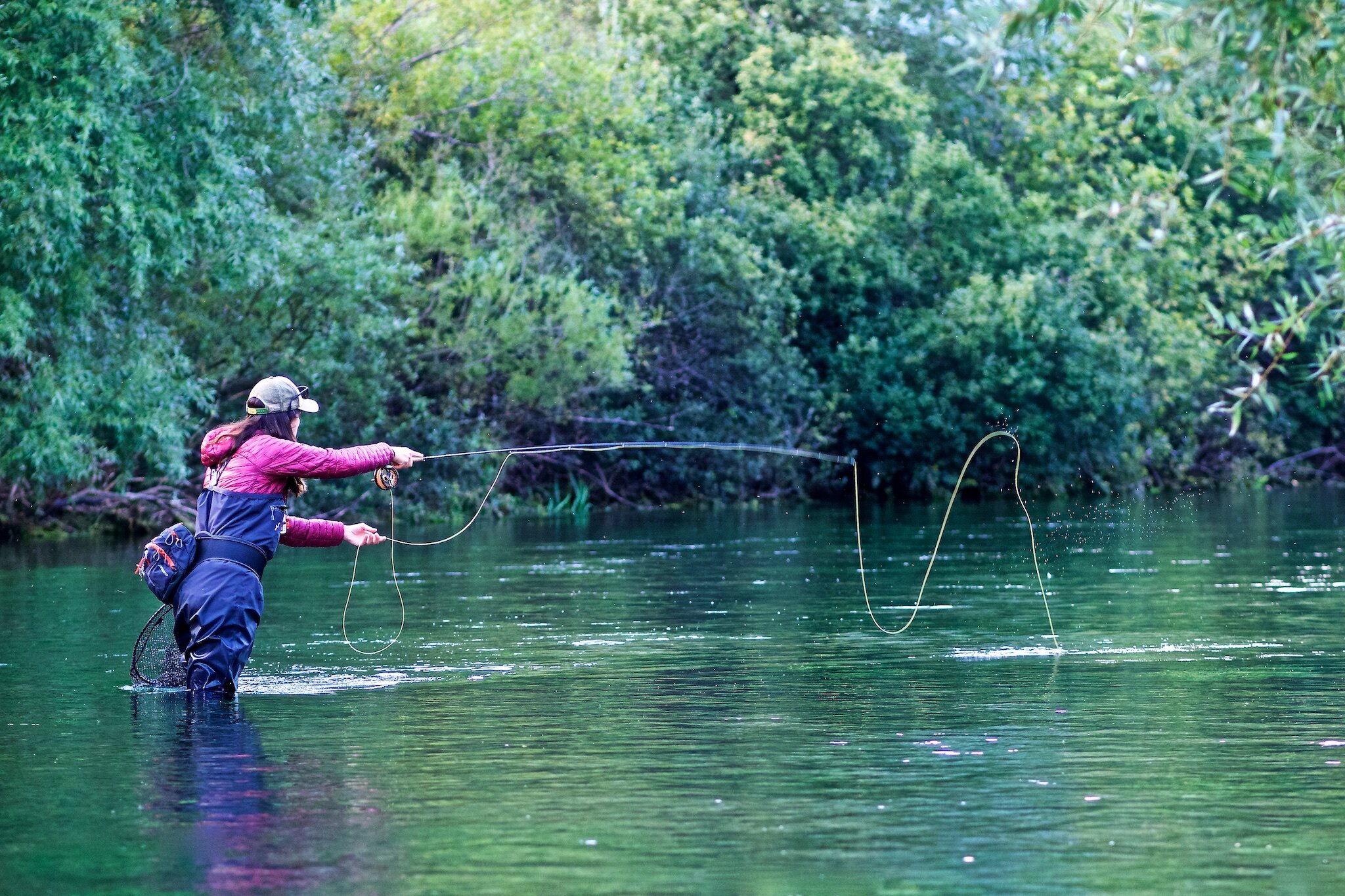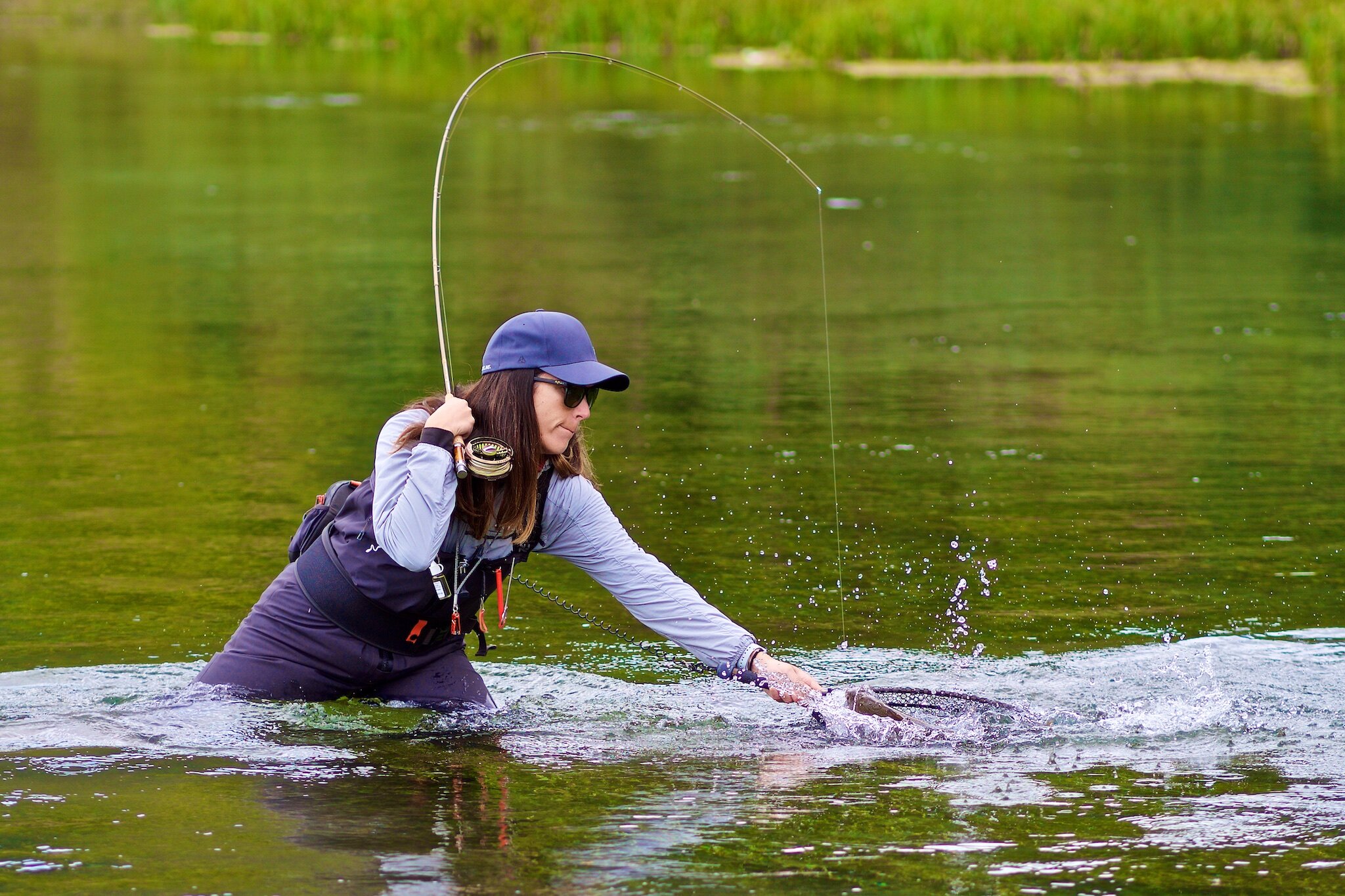
Parachute #16. Photo by Chris Dore
Aitor Coterón
Photos by Aitor Coterón and Alvaro G Santillan
1. Choice of equipment Rods, reels, fly lines, fly floatants, clothes, glasses and other useful items.
I friend of mine has been a professional photographer for many years, apart from directing a photography academy. When addressing the usual beginner’s question about what camera to buy or which one is the best, his reply is always the same: “The best camera is that you have with you when the opportunity arises”.
Time ago I stumbled upon some sort of internet “guidebook” on how to choose a new camera; it made a very lucid point as well: “Before buying a new camera honestly review all the things that the new device is going to do for you that your old one can not.”
I find those ideas totally applicable to fly rods, and any other gear for that matter. As I like to tell my casting students: If I could buy me a Ferrari my driving would still be as average as usual. So never expect a new rod to solve your technical problems. Spend that money in improving your casting skills and, most probably, you will look at your current rod with new eyes.
Anyway, I must declare that I am guilty of breaking my own rules many times. I can’t deny that a new rod is always a pleasure!
There are so many good rods around that choosing one is just a question of personal preference, and preferences change. Not so long ago 9’#5 sticks were the indisputable leaders of the Spanish market. Now, in Spain, that stuff is anecdotical: everything has to be 10’+. The Spanish nymphing technique mentality.
So, over here, most people fish dry flies with long rods —if they decide to knot a dry fly in the first place, which is a pretty rare event, to be honest—, because that is what they have.
I don’t like such long rods for dry fly work: the longer the rod the harder it is on your joints, and dry fly fishing requires much more casting than Spanish nymphing. Obviously a longish rod has advantages for removing as much line from the water as possible to avoid drag, but I enjoy trying to solve drag problems by means of proper positioning and casting tactics; moreover, my joints aren’t what they used to be when I was young. On the other hand, accuracy is harder the longer the rod —just try to thread a small fly holding a 2 cm long piece of tippet instead of 0.5 centimeters to see what I mean.
I use rods from 7’6”#3 to 8’, 8’6”#4 to 9’#5, #6, depending on the circumstances —shots of 20+ meters in the wind ask for a different tool than short casts on narrow overgrown streams. Lightness is key to me, and perceived lightness is also a matter of length, so, when in doubt, I resort to light and short.
A final tip on shifting from a short rod to a long one: Keep in mind that using the same arm motion when setting the hook will probably be too much for your tippet: a longer lever amplifies both speed and distance covered by the rod tip.
Reels: Dry fly fishing is about grace, so, in my view, the lighter the better. In that regard evaluate if you really need a drag mechanism; palming is usually more than enough for me.
Lines: Nowadays WFs. Not because they present the fly differently than a DT —the key to that is on their respective front tapers— but due to the enormous choice of profiles that aren’t possible in the case of DTs. The ability of easily shooting line is a bonus in some circumstances.
I normally take three different line weights with me: #4, #5 and #6.
Calm day and/or picky fish? The #4 weight.
Wind and long leaders/casts or big flies? The #6 weight.
All on the same rod, most probably a #4 or #5 weight.
Other useful items:
We are all entitled to our bragging rights, it is part of the fly fishing heritage. However, balancing those “the really big one got away” and “my smaller fish was 50 cm long” with some objectivity, doesn’t hurt either. It is when a McLean landing weigh net and a measuring tape come in handy.
A very particular perversion of the bragging rights is that one in which your fish tend to get bigger and bigger with time, while your partner’s ones get smaller and smaller. Following is the rough method of fish size estimation employed by a fishing buddy of mine:
Around one kilo fish
Caught by him: “Big brown!”
Caught by me: “Hmmm… Not baaad”
Around two kilo fish
Caught by him: “Enooormous trout!”
Caught by me: “…Nice one”
Sorry man, your freedom to brag ends where mine begins! So long live McLean net! Use it regularly, and you will eventually develop the eye to visually asses the weight of a fish and even earn some beers in the process.
2. Leader material, build up, length and knots
Commercial tapered leaders are well balanced and, most importantly, they are knotless. When fishing rivers abundant in water vegetation knots pick up grass, either during the drift (compromising its drag-free character) or when playing a fish (with the risk of losing it). So all my leaders are made from a commercial knot-less one (12’ 3X or 4X) which I modify adding a tippet section of 5, 6 or 7X monofilament. Depending on the conditions they go from 4.5 to 7 meters long.
One interesting thing to notice: you don’t need many sections of monofilament (and their correspondent knots) to go from 3X to 7X. I will quote Gary Borger explaining it:
“Many fly fishers believe that to build a tapered leader each new segment that’s added must be no more than 0.002 inch smaller than the last segment or the leader will “hinge”, i.e., collapse back upon itself and not turn over. This is absolutely NOT true. In fact, the cross-sectional area of the leader can be reduced by 60 percent and the leader will not hinge. A 60 percent reduction in cross-sectional area is the same as a 35 percent reduction in diameter.”
Check regularly your tippet for nicks or knots. In fact, check the thicker parts of the leader as well: at times there are breakages in the 5X instead of the 7X further down. And I have a recent memory of that. Lazyness doesn’t pay off.
After changing a fly check the tippet to hook knot twice, and the rest of knots as well.
Change your leader/tippet whenever conditions ask for it. Many times turning a bad drift into a good one is about tweaking your setup. Lack of motivation after a long period of slow fishing leads to lazyness, and the latter will never improve motivation. Paraphrasing Picasso: When inspiration comes I prefer it to find me working.
The ever shortening tippet: every change of fly changes the drifting characteristics of your leader. Take it into account as well when thinking of drag. Note to myself: and, again, don’t be lazy.
I have never bought relating leader length to rod length. I mean those fixed rules along the lines of: “Your leader should be 1.5 rod lengths long.”
For instance: Let’s say I take to the river an 11’ rod and an 8’6”. I prefer the short one, but want to try that popular 11’ stick. I start with the 8’6”. If I opt for “two rod lengths” of leader this would be 17’ long. Let’s say that with that set up I get good drag-free drifts. Then I change to my 11’ rod, and by applying the same approach my leader is 22’ long now. That makes a 1.5 meter difference. The longer the leader the harder it is to control, so what’s the point of using such a long leader if I could be fishing well with a shorter one? Leader length is dictated by several variables (fly, wind, water level and clarity, fish behavior...); rod length isn’t one of them.
3. Approach and stealth
I think that stealth is self-explanatory when dealing with wild animals: be sloppy and they won’t be there anymore when you arrive.
Regarding approach it comes to my mind what Dean Harrison told us during a briefing before our first guided fishing day in the New Zealand back country:
—If you can make the cast from the bank don’t get into the river.
A couple of days after that, I was presenting a CDC&Elk to a very nice fish lying close to my own bank. The big brown saw the fly drifting down towards it, took a look... and went on looking while following the floating fly downstream for 1, 2...,7, 8... meters, till its eyes took notice of my feet which were happily enjoying the cold water. When the fish disappeared like a rocket, Deano asked:
—Do you remember what I said the other day?
In fact, then, I did.
It is important to notice that, just like humans have diverse cultures, fish differ in their character as well. Trout and grayling may show a different behavior not only from country to country, but even from one river to another.
San Juan river, New Mexico; you are very focused in covering a pod of rising rainbows; after a while you turn round to the surprising sight of a dozen fish feeding on the macro invertebrates you are unconsciously removing from the bottom. They get so close that, if it wasn’t for water density, you could kick their noses with your heel.
On the other hand you can experience exactly the opposite. This an excerpt of an article I wrote long ago about river fishing in Northern Spain:
“Two minutes after landing, the fly hasn’t moved even one centimeter: the current in the center of this curved pool is slow but here, close to the inner bank, is plainly non-existent. An eternity later I see, at last, the wake of the patrolling trout coming in the general direction of my fly; it gets closer and closer… then the fish stops with its nose almost touching my fly; time stops too. I prepare myself for the strike trying to keep calm —I am very prone to bursting tippets when confronted to this kind of anticipated takes. Suddenly the water explodes and the fish bolts away, leaving the fly behind, heading for his lie in the undercut of the opposite bank. I never imagined that the sight of a Parachute Adams #26 could be as terrifying as that!”
Some short notes on the subject:
All anglers know that fish seem to have a strange predilection for the opposite bank… Just be aware that your own bank is the opposite one of someone else, and may hold as many fish as that in front. So do look purposefully before entering the water; a big wake running away will eventually remind you of this if you don’t.
Never lose sight of your drifting fly. If you need to fix something in your tackle remove your fly from the water. Lack of focus equals missed fish. Maybe The Fish.
If you are tired and feel unmotivated stop fishing. Take a break; a nap; have a beer or two; whatever. Lack of focus equals missed fish. Maybe The Fish.
Moving to a new casting position with fly in hand and some line and leader hanging from the rod tip thinking of saving time isn’t a good idea. You will waste it instead by tangling your line/leader in every vegetable material in sight or even out of it. I should tattoo this one in my casting hand!
Change position, casting tactics or both before changing your fly.
Check your surroundings, specially up and behind you before starting to cast. Trees don’t need more decoration, they are beautiful as such.
And last but not least, as some lucid angler wrote somewhere: “During a feeding frenzy… Don’t eat!”
4. Reading the water
Fish needs are: food, protection from the current, and protection from predators. Look for water displaying those traits and you will be in the right path. There are excellent books dealing with this subject so I won’t bore you with my musings which wouldn’t add anything new in that department.
Spotting fish is an art in itself. I’d love to write extensively about the subject but my skills in that subject have traditionally been close to none; my deteriorating eyesight doesn’t help either. Fortunately, I can count on the eyes of some friends that are like ospreys.
Just one rarely mentioned thing comes to mind:
Trout always look upstream; the problem is that upstream doesn’t always mean upriver —think of back-eddies.
So always analyze the current’s real direction before positioning yourself and making your first cast, otherwise your fly may drift in a different direction than expected and start dragging immediately; moreover, you could be exposing yourself to the fish in plain view.
5. Casting ability; which casts are essential
If you ask fly fishing guides what is the one thing that they would like their clients to be able to do better in order to catch more fish, the answer is not that they could tie better flies, tie better knots or owned better equipment. It is resoundingly that they should cast better.
If you ask fly casting instructors what is the one thing that they wish that their clients would do better, the answer is not that they read more books, watch more videos or even that they have more lessons (although that can help!). It is that they practice more.”
Paul Arden
Of all the casting techniques available I find that Oval, Reach and Parachute casts are the bare essentials every angler should have in their toolbox. The bonus is that all those skills are easy to acquire, as each of those casts is just a small variation of the basic overhead cast:
Oval: just change the casting plane of your backcast to, more or less, horizontal.
Oval casts are great for heavy nymphs while protecting your rod… but also for casting any kind of fly in confined spaces. They help in keeping your fly box well stuffed: it is always better to snag a branch on your backcast at head height than five meters above you.
Reach: simply modify the follow-through after loop formation by lowering the rod to one side instead of vertically.
Reach casts allow for a better angle between line and current flow to help in getting drag-free drifts. They are also excellent when presenting directly upstream to avoid “lining” the fish.
Parachute: again alter the follow-through by moving the rod tip backwards.
Parachute casts give you slack line close to the rod tip. Great for downstream presentations, specially when combined with a Reach cast.
Some additional hints: When your fly gets close to the target, study the configuration of the line on the water. That is the radiography of dragging disease.
Think of fly drag before thinking of fly change.
Watch your backcast when training. A little bit of wading, long leaders, thin tippets, moderately or plainly long casts… on their own or combined, are a recipe for backcasts disasters.
6. Entomology; what we should know ?
I admire the knowledge of the angler-enthomologist but I don’t have the time to get deep into such a complex subject. So I opted for a simple approach: I need to know about insects as much as fish do; if that works for them —and nothing less than their life depends on it!— it should work for me. That removes latin names and complex identification procedures from the equation, so what’s left is size, shape, colour, position in relation to the water surface (on or in) and behaviour. Something you can check on the spot.
In my view, of all those categories, colour is the less important. Individuals from the same species may differ in colour along the very same river, not to say among different rivers. In fact, colour by itself isn’t an identification key in scientific terms.
This sounds weird —even heretical—over here in Spain, where colour is king, but...
7. Rise forms. Can they tell us something?
In dry fly fishing, the fish’s menu may drift at different levels: adult aquatic or terrestrial insects float on the surface; emergers and emerging nymphs ride just below the film. When taking the first category the fish show their heads and mouth; if the plat du jour is of the second category, the fish usually rise with a head-and-tail motion. Anyway, there are very different behavioral patterns among the trout of the world: from the vertical, deliberate and slow emerging of the whole head of the Green river’s browns, to the lightning fast take of a Bosnian grayling which seem to be able of spitting your fly almost before touching it. The only answer is first hand experience.
One important thing: Study each rise carefully: sometimes a light dimple in the water surface is the telltale of some unexpectedly big fish. On the other hand, violent, splashy rises may correspond to small guys.
8. Fly selection; size; shape; materials; essential flies; favourite fly
As the old Spanish saying goes: A fool at home is more knowledgeable than a smart guy in other’s house.
So when traveling I always pay a visit the local fly tier. He will know more than me for sure.
Regarding materials I am not a believer in magic. In Spain there is a strong tradition of using a particular brand of silk thread to make fly bodies. People get super picky about specific colours, some of them reaching prices of top class rods for a small spool of thread. Then you go to Bosnia and, as their economic situation is really bad and don’t have the money for those luxuries, they tie their fly bodies with normal, basic tying thread. And their flies look and work beautifully.
There are some flies that I always take with me wherever I travel: CDC&Elk, Parachute Adams, Royal Wulff, Shuttlecock.
Favourite fly? Currently that Bosnian style olive emerger on the picture below. It seems to work everywhere when there is a hatch in progress... and even when there isn’t one. trumps imitation. In fact, in my view, presentation is the highest form of imitation, for behavior is key in recognizing any living creature as such. Pablo Castro, one of the top Spanish fly fishing competitors, has a very illustrative point in this regard:
“Some day I saw a perfect human figure drifting helplessly down the river. I Immediately thought: where does this manikin come from? But some other day I found what, in the end, was just a strange looking pile of man’s clothes in the shallow water close to the bank; the sight startled me: somebody got drowned!!”
Fly selection
9. Presentation and drifts
Fly fishing is about a small artificial thing looking like the real one. In dry fly fishing that means —normally— drag-free drifts. That’s what presentation is all about.
It is easy to detect a fly that crosses the current like a water skier, but drag is more insidious than that: even the slightest tension affecting the fly is perfectly discernible to the fish.
Some day many years ago, on a Bosnian spring creek. Trout and grayling were raising everywhere, and my guide knew perfectly well what emerger imitation they were going to take... if the drift was absolutely drag-free, that is. My first tries at a specific fish were useless; time after time my fly covered the fish’s position with what, to me eyes, were good drifts, but getting not even a look. After a while my guide said:
—Not even one of those presentations has been right.
I was surprised, as I hadn’t noticed any wild behavior on the part of my fly. Prpa said:
—Try again; that was a little better. Again; that was better, but still not perfect. Now! It will take this one!
Then the grayling rose with utter confidence and took my small emerger. That day I learnt a lot about how to properly asses a drift.
So look purposefully to discern hidden drag. Many times the difference between bad and good drifts is really minute!
Take fly drag as a given, and act accordingly starting with your cast. Always.
Having that point above in mind, don’t expect to fix with your line already on the water what you didn’t devise while it still was in the air.
10. Upstream or downstream?
If upstream dry fly only is the rule stablished in some English chalkstreams, the unspoken rule in the Balkan spring creeks is exactly the opposite: downstream dry fly only, this time imposed by the fish themselves; it is the only law that incorporates in itself the punishment of those who violate it.
Reach, check, pile and parachute casts, combined, are the ingredients of the downstream approach. One of its indisputable masters is guide, top-class competitor and great friend, Prpa. It was him who, many years ago, introduced me to the downstream dry fly fishing scene, which, at the time, was totally unknown to me.
A couple of years ago, while he was guiding me on his home waters, I was thinking of a couple of classes about presentation techniques I had to impart in two weeks time to a group of top-class competition anglers, and decided to ask the master himself about which casts he would choose to teach in my case:
—There are only two presentation casts, Aitor: upstream and downstream.
My expression of puzzlement made him to consider that he probably had been too laconic, so after a while he added:
—Downstream is better.
That was all.
He obviously is in the camp of the fly casting “poets”. Too much of a poet, if you ask me.
Downstream presentations shine when dealing with the maze of uncountable conflicting currents you typically find on spring creeks. As a rule of thumb, the higher the number of currents of different speed that your line crosses, the harder it is to get a drag-free drift. The water pulling on your line and leader in different directions and with different force, leads to tension, and tension in the fly results in it being disdained by any trout or grayling with a minimum of dignity. Obviously, when all of the line at play is way upstream of the fly and forming a shallow angle with the flow, things get much easier. And it gets reflected in the results.
By means of presenting downstream you can get the longest drifts imaginable —even the whole line, if that suits the situation. For the same scenario the quality of the drift is not comparable to that of an upstream presentation.
Of course, this approach isn’t universal, so to speak. It would be a big mistake to try to totally replace upstream presentation with it, as there are scenarios and fish that won’t allow its use. By the same token, it isn’t very smart to stick to upstream presentations exclusively, as sometimes the opportunity for thinking outside the box arises when you least expect. For instance, addressing a prime lie protected by overhanging vegetation from upstream may be the answer to what you, so far, considered close-to-impossible lies.
New Zealand backcountry two years ago:
At last! A long and deep pool of gin clear water! After a very long, sweaty hike upstream, where the river looked much more suitable for whitewater sports than for fishing, this was a really relieving view. I started scanning the water in the tail, slowly progressing upstream. Nothing. I was close to the head of the pool when I saw the fish: a big brown trout patrolling the slow water in the far bank, lazily taking bites erratically from the full-of-debris surface.
With all that defeaning chirping from the cicadas around it wasn’t hard to choose a fly pattern. At its head, the pool was narrow, with a fast tongue of current in the middle. In its search the fish was following a rather inconsistent upstream-downstream-upstream path; always beyond the strip of faster water, of course. I had to wait for the trout to be looking away from me to make a cast. Some good casts were useless, as the fish changed direction unexpectedly. And when things seemed to be right, drag resulted in a number of disdainful looks. A reach cast —no matter how exaggerated— wasn’t enough to counteract the big difference in speed between the two pieces of water and I couldn’t wade more upstream of my current position. Not an easy challenge.
Finally, the trout decided to search farther downstream. Following it along my own bank I got to a place where the problematic current was slower and, by presenting my fly well downstream instead of across, I had a much better angle to make a good reach cast that placed the line close to parallel with the current and way upstream of leader and fly . Soon after, the brown was posing for the picture below.
When everything was finished I reflected on how many times the thrill of the moment doesn’t allow us to think clearly. Why didn’t I use a downstream presentation from the start? All I can say is that the view of any active big fish, apart from leading to trembling hands, tends to slow down my mind.
11. Fighting fish
Playing a fish is always preceded by hooking it, so let’s address that issue first with some short hints:
Slack line is a must for a drag-free drift, but make sure that it doesn’t compromise your ability to strike effectively: too much slack combined with fast-spitting fish and you are done.
When in doubt pull, it could be a fish, even The Fish. This is pretty evident with nymphs and streamers (I keep some painful memories of that), but even the disappearance of that dry fly, apparently sucked in by a small swirl, could be the telltale of a different story.
When playing a fish always stand with your feet and legs touching each other. I even managed to break the tip of a new rod when a trout changed its mind, deciding that running downstream through a perfect channel between my legs was much more relaxing than fighting the current.
Learn how much you can pull before breaking your tippet. Afer a casting session on the lawn you can tie one of your fishing leaders to a branch, a park bench or any other “fish” you have available. Then pull using different rod angles. If you have a 4X tippet and pull with the rod butt upright be careful lest you break the rod tip.
Never ending photo sessions surely kill fish, but, as a photographer, I must add that many of them were already dead before coming to the net due to a never ending “fight”; and nobody addresses that important issue. So let’s take a look to this.
When talking about levers what everyone has in mind are those resembling a see-saw that acts by multiplying our force. Those are first class levers.
Rods are levers, but not of that class, they are third class levers and, in that regard, they give mechanical advantage to the fish: it is them that see their force multiplied, not the angler! And the longer the lever (the rod) the bigger the force the fish exerts on you! That’s why rods for fishing the big blue are short.
In practice, if the imaginary line that connects your hand with the hooked fish and the rod butt form an angle of 90º, you are exerting minimal force on the fish. On the other hand, if you point to the fish directly with the rod butt, turning that angle into a 0º one, you are exerting maximum force on it.
That simple angle change modifies what is known as “effective lever length”, making your rod shorter or longer at will —so to speak.
If the fish runs, a 90º angle protects the tippet by applying minimal force. But when the fish stops it is time to bring it to you, so you must decrease the effective rod length by changing your rod angle.
If you think about it you have been using this concept regularly: how is your rod positioned when you need to break a fly stuck in a high branch? Just use it more often and in other circumstances, as when playing fish, for instance. Then you will be able of shooting some nice pics of your quarry without worries.
One final point: Lateral pressure is a well known fish playing technique. However, be aware of the fact that pulling laterally without diminishing the rod angle, doesn’t increase the force you are applying on the fish. What pulling laterally does is to compromise the fish’s ability to swim, as it needs to move its head from one side to the other to do that. Combine that lateral pulling with a decrease in the angle of pull and you’ll be amazed by the results.
Search for beauty, it is one of the few really precious things in this crumbling world; and for that I don’t know of a better way than fishing the dry fly.

